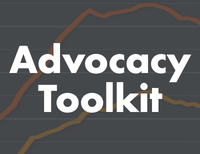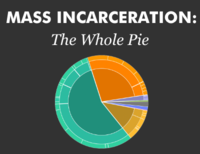New research finds higher county jail rates have deadly consequences for entire communities
A recent study from a researcher at University of Pennsylvania finds that higher jail rates are associated with higher death rates, especially for Black people and women.
by Emily Widra and Wendy Sawyer, January 30, 2025
The health, social, and economic harms of incarceration extend far beyond the people behind bars to their children, families, and entire communities, as a large body of research has shown. New research from Anneliese Luck at the University of Pennsylvania adds to this evidence, finding strong links between higher county jail incarceration rates and higher county mortality (death) rates. While researchers have already established the clear connections between jail incarceration, community health, and deaths, Luck’s analysis in The Distribution of Carceral Harm: County-level jail incarceration and mortality by race, sex, and age reveals how these connections vary across age, sex, and race. Generally, Luck finds that higher jail rates are associated with higher death rates for Black people and for women than for white people and men — with the notable exception of older Black men, for whom the “mortality penalty” of higher jail rates is most dramatic.
Luck’s analysis of racial differences is a particularly important contribution, given that the burden of incarceration falls disproportionately on Black communities. While Black people make up less than 14% of the U.S. population, they account for 42% of people who are incarcerated; unsurprisingly, Black people are also overrepresented among people with an incarcerated family member. Ultimately, Luck’s breakdown of the relationship between higher jail rates and elevated death rates by demographic characteristics gives us a clearer picture of the carceral system’s disproportionate impacts on the health and well-being of some of the most vulnerable populations.

Methodology
It may be useful to define some of the terms used in Luck’s study and in this briefing discussing her findings. The main variables of interest are:
- County-level jail incarceration rates (more simply, “jail rates”): This is the number of people held in a local jail relative to the number of people in the jail’s jurisdiction, which is usually a county (jails are usually run by counties or municipalities). Incarceration rates are typically expressed “per 100,000 residents,” but they can also be calculated for specific groups within the larger population — for instance, Luck uses the number of Black people in a county jail relative to the number of Black people in the county to express the county-level Black jail rate. A higher jail rate indicates that the county incarcerated a larger portion of its population.
- County-level mortality rates (or “death rates”): This is the number of people in the county who die within a certain time period (in this case, five years), relative to the total number of people in the county. This rate is also expressed “per 100,000 residents” or per 100,000 people who share a certain characteristic, such as race, sex, or age group. A higher mortality rate indicates that a greater portion of its residents died over a certain period of time.
- Race, age group, and sex: The data used in Luck’s study include two racial categories (non-Hispanic Black and non-Hispanic white), five age groups (19 and younger, 20-34, 35-49, 50-64, and 65+), and two sexes (male and female).
As an additional note on the language used in this briefing, we (like Luck) also use the term “mortality penalty” as a kind of shorthand to describe the increase in death rates associated with increases in jail incarceration rates. While the word “penalty” often implies a causal relationship, it’s important to note that the findings we discuss describe correlations between county jail rates and county death rates, not direct causes and effects.
For data sources, Luck used the race-specific1 jail incarceration rates from the Vera Institute of Justice’s Incarceration Trends database2 for over 1,000 counties across the country.3 She calculated the county-level death rates by combining restricted vital statistics death data from the National Center for Health Statistics with publicly available population estimates from the U.S. Census Bureau by age, sex, race, ethnicity, county, and year; this gave her age-specific death rates by county and year for four groups: Black men, Black women, white men, and white women. She then pooled (merged) the county death rates for 2010-2014 and 2015-2019, which she analyzed in comparison to the 2009 and 2014 jail incarceration rates, respectively.4
In this study, the average jail incarceration rate for Black people across all counties in the sample (1,060 per 100,000 Black residents) is more than four times that of white people (260 per 100,000 white residents) in 2014.5 This is a reflection of the well-documented racial disparities in U.S. incarceration. There is also a much wider range of county jail incarceration rates for Black people than for white people: one standard deviation6 in the race-specific jail rate is 1,500 per 100,000 Black people, but just 400 per 100,000 white people.7 Because of these differences, the findings of this study are expressed differently for Black and white populations.
Luck analyzed the data using two models that each included different variables; both showed strong, statistically significant links between county-level, race-specific jail rates and death rates across both sexes and races, and across almost all age groups. The first model simply looked at the relationship between the county-level, race-specific jail rates and the county-level death rates of the various demographic groups. In the second model, Luck controlled for a number of county-level characteristics like poverty rate, violent crime rate, percent with a college education, urbanicity, and race, age, and sex distributions. This more sophisticated model accounts for factors besides jail rates that could explain the differences in death rates, to try to isolate the relationship between jail rates and death rates as much as possible. In this briefing, we focus on the results of this second model.
Limitations of the study: Some contextual notes on the findings
Like every study, this study has some limitations. Luck relies on existing data gathered for different purposes, so there were some constraints on how she could use the data to assess the relationship between jail incarceration, deaths, and demographics. She explains various data limitations in her publications, but we thought these two were worth noting here:
- The sample was limited to counties with large enough Black and white populations to allow for valid comparisons between racial groups. So while the sample represents the majority of the nation’s Black and white residents, it reflects a somewhat more racially diverse and less rural subset of counties than we would see if every single county was included. In order to include as many less-populous and rural counties as possible (375 in the final sample), Luck pooled the mortality data into two five-year periods (instead of looking at just a few deaths in a county in one year, she used the larger number of deaths over a five-year period).
- Previous research indicates that the association between jail incarceration rates and community death rates weakens over time: the link is strongest when you compare jail rates to mortality rates a year later, and weaker when you compare them to mortality rates five or ten years later. Because Luck uses mortality data pooled across a five-year period, her analysis likely underestimates the associations she finds in this study.
To be clear, these limitations do not diminish this study’s contribution to a robust body of evidence of the harms of incarceration on entire communities; they simply provide additional context.
Key findings from this study
The results of this study support our understanding that policing and criminalization disproportionately impact the same communities that are most vulnerable to any number of negative outcomes, including high unemployment rates, decreased life expectancy, worse health and worse access to healthcare, and exposure to environmental dangers, inevitably contributing to the observed differences in community death rates.8
Race-specific measures reveal more about the link between incarceration and death rates
By incorporating race-specific measures into the analysis, Luck’s new study is able to show how different demographic groups in the same communities fare under aggressive jailing. Importantly, it also demonstrates that using “race-neutral” measures, as most previous studies do, actually underestimates the scale of the “mortality penalty” — that is, the increase in death rates associated with increases in jail rates. To show this, Luck ran her analysis again using total population rates (i.e., not differentiated by race), and found increases in total jail rates were associated with death rate increases of 0.3 to 1% across the various demographic groups she studied. While this is a statistically significant difference, using race-specific measures yielded a much greater difference in death rates (1.4% to 1.9%). As a result, the new study’s use of race-specific data provides a more nuanced look at the people facing the most serious harms associated with jail incarceration.
Higher jail rates are associated with greater increases in death rates for women than men
The new study finds that both Black and white women’s death rates in almost every age group increase more dramatically with higher jail rates than men’s do. An increase of one standard deviation in the white jail rate (400 per 100,000) corresponds to an increase in the death rate by 1.4% for white men and 1.9% for white women of all ages. An increase of one standard deviation in the Black jail rate (1,500 per 100,000) corresponds to an increase in the death rate by 1.8% for Black men and 1.7% for Black women of all ages — but this is driven by a single age group of Black men (65+) for whom the increase in mortality is more than twice that of Black women (65+), as we explain below. For all other age groups, the “mortality penalty” is higher for Black women than Black men. Because men are incarcerated at rates far higher than women,9 the impact of the carceral system on women’s lives is often overlooked, but this research underscores the need to study how mass incarceration endangers women’s lives inside and outside of jails and prisons, too.

As other research has shown, jail incarceration disproportionately impacts women’s well-being and health in a number of ways. The rising jail rates of women mean that more and more women are directly impacted by the carceral system, and those women are more likely to have medical conditions and face higher jail death rates than men. Indirectly, women are profoundly impacted by the detention and incarceration of family members: 1 in 4 women have had a family member incarcerated. Higher incarceration rates are associated with a host of negative health consequences for non-incarcerated women: increased frequency of adverse reproductive health outcomes, diminished access to healthcare, and elevated rates of new HIV infections. There are also serious financial repercussions for women with incarcerated loved ones which can ultimately have downstream effects on health and mortality.
The one exception: The “mortality penalty” is greatest for Black men 65 and older
The larger increases in women’s death rates that we see with higher jail rates are consistent across all age groups and both races — except among Black people 65 or older. Across counties with higher Black jail rates, the death rates of Black women under 65 were 1% to 3.4% higher (depending on the age group) than in the counties with lower Black jail rates; these are greater differences than observed among Black men under 65 in the same counties. However, for people 65 years or older, this trend was reversed: higher Black jail rates were associated with a 2.1% increase in death rates for Black men over 65, but a smaller 1% increase in death rates for Black women over 65.10 The author explains the implications of this finding:
“The disproportionate toll absorbed by older Black populations—particularly men, and largely driven by coupling of the increasing penalties of jail incarceration with already high levels of mortality—calls attention to the ways racial inequalities in incarceration may exacerbate other forms of socioeconomic, political, social, and health disadvantage that have been historically shouldered by Black individuals in the United States.”
Because Luck’s research is among the first to examine the relationship between jail incarceration and mortality by race, sex, and age, these findings offer new and damning evidence for what we already know: the burdens associated with incarceration are disproportionately carried by those who are already most vulnerable to other socioeconomic disadvantages.
Conclusion
This study contributes to the growing body of evidence that mass incarceration has fatal consequences that extend far beyond jail cells and prison walls. Luck’s use of race-specific jail rates to assess the ways in which jail incarceration affects white men and women differently from Black men and women calls attention to the racially disparate community consequences of incarceration.
Women and older Black men are particularly vulnerable to the “mortality penalty” associated with higher jail incarceration rates, suggesting that jails contribute to the “uneven geography of health and mortality” across the United States. In addition, this research underscores the role jails and short jail stays play in public health. While much research on the association between population-level health outcomes and incarceration has been focused on policing and prisons, these new findings emphasize the need for research to incorporate local jails into our understanding of how the carceral system hurts the health of individuals, families, and communities.
Footnotes
-
“Race-specific” rates are rates calculated for a specific racial group. The race-specific jail incarceration rate is the number of people in jail in a specific racial group relative to the total jurisdiction-wide population of that racial group. ↩
-
In its Incarceration Trends dataset, Vera presents jail incarceration rates for counties per every 100,000 residents aged 15-64. Because these jail incarceration rates exclude youth under 15 years and older adults, we can assume they represent at least a slight undercount of the total number of people incarcerated in jail. In 2022, the Bureau of Justice Statistics reported that there were 1,900 people under 18 years old in local jails, but we do not know how many of those youth were under 15 years old. Vera’s Incarceration Trends dataset has been used frequently in studies of mortality and incarceration, including Kajeepeta et al. (2021), Weidner & Schultz (2019), and Nosrati et al. (2021). ↩
-
Luck included counties with populations of at least 5,000 people in each race-sex category (Black-male, Black-female, white-male, white-female) in her analysis. Ultimately, the study included 1,103 counties, representing more than 95% of the total U.S. Black population and approximately 76% of the total U.S. white population. Luck explains that while this sample is not entirely nationally representative — for example, the sample reflects a slightly more racially diverse and slightly less rural subset of counties — there are only “marginal” differences between this sample and all counties in the U.S. in terms of mortality, jail incarceration, and the county covariates (county-level poverty rate, violent crime rate, college education, percent of population that is Black, percent of population that is male, percent of population that is aged 20-30, and urbanicity). ↩
-
Luck explains that she did this to ensure the temporal ordering of the relationship between jail incarceration rates and the subsequent five-year pooled death rates. Her use of the two time periods (2010-2014 and 2015-2019) offered more stability to her mortality estimates and allowed the inclusion of more counties. For more information on this process, please see the author’s explanation in her Data and Methods section. ↩
-
These rates are slightly different from the race-specific jail incarceration rates calculated by the Vera Institute of Justice, which were 944 per 100,000 for Black people and 266 per 100,000 for white people in quarter two of 2014. These rates differ because Luck indirectly estimated the mean (average) incarceration rates based on a weighted average of race-specific jail rates across counties, weighted by the total population. ↩
-
The standard deviation is a measure of how much variation there is in a certain measure (like county-level jail rates) within a sample population (like the counties included in a study). Where there is wider variation in the individual data points, the standard deviation is greater, and where there is less variation, the standard deviation is smaller. Standard deviations can be useful to distinguish between observed measures (like county jail rates) that are more typical (closer to the average for the population) versus those that are especially low or high compared to the others in the dataset. That is how Luck uses standard deviations in this study: when she uses “an increase of one standard deviation” to describe a difference in jail rates, you might think of that as “in counties with jail rates well above average for the population” or “in counties with higher jail rates than most.” ↩
-
Luck expresses the standard deviations as changes in percentage points, which we reframed as change in incarceration rate: for example, an increase of 0.4 percentage points from an incarceration rate of 1,000 per 100,000 would be 1,400 per 100,000 people, and an increase of 1.5 percentage points from an incarceration rate of 1,000 per 100,000 would be 2,500 per 100,000 people. ↩
-
Because of the nature of the data and research included in this study, we cannot necessarily draw causal conclusions about the direct impact incarceration rates have on mortality rates. ↩
-
In 2022, men had a national jail incarceration rate of 345 per 100,000 male residents, while women had a jail rate of 55 per 100,000 female residents, according to Table 4 of the Bureau of Justice Statistics report Jail Inmates in 2022 — Statistical Tables. ↩
-
This finding adds to what we know from existing research showing that Black men disproportionately experience the serious health implications of incarceration, frequently appearing later in life. ↩




